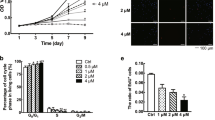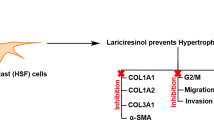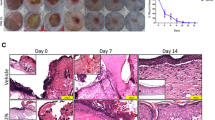Abstract
Tranilast is used clinically as a drug for hypertrophic scars or keloids. Recently, the roles of keratinocytes in the pathogenesis of those conditions have been noted. Therefore, we first examined the effect of tranilast on the cell growth of normal human keratinocytes. A cell growth assay demonstrated that the cell number significantly decreased during 48 h cultures with the addition of tranilast (5–400 μM) compared with a control (tranilast 0) in a dose-dependent manner. Morphologically, cell spreading was decreased and the cell body was elongated with higher concentrations (200–400 μM) of tranilast, and the cell area decreased significantly. The effect was not due to cytotoxicity. The inhibition of cell growth and the changes in cell morphology by the treatment of 100 μM tranilast reversed after the removal of the tranilast. Immunohistochemical staining revealed that F-actin and vinculin expression with tranilast-treated keratinocytes decreased significantly in a dose-dependent manner (100–400 μM). In addition, cell cycle examination showed that 400 μM of tranilast caused G0/G1 arrest with the keratinocytes. From these data we concluded that tranilast inhibited the growth of normal human keratinocytes, and one of its mechanisms may involve decreasing cell spreading by inhibition of F-actin fiber and focal contact formation with the cells.






Similar content being viewed by others
Abbreviations
- CEGM:
-
Complete EpiLife growth medium
- CV:
-
Crystal violet
References
Azuma H, Banno K, Yoshimura T (1976) Pharmacological properties of N-(3′,4′-dimethoxycinnamoyl) anthranilic acid (N-5′), a new anti-atopic agent. Br J Pharmacol 58:483–488
Bellemare J, Roberge CJ, Bergeron D et al (2005) Epidermis promotes dermal fibrosis: role in the pathogenesis of hypertrophic scars. J Pathol 206:1–8
El Ghalbzouri A, Ponec M (2004) Diffusible factors released by fibroblasts support epidermal morphogenesis and deposition of basement membrane components. Wound Rep Reg 12:359–367
Fujii K, Danno K, Ikai K et al (1988) Inhibitory effects of N-(3,4-dimethoxycinnamoyl) anthranilic acid (N-5′, tranilast) on the growth of mouse keratinocyte cell line in culture. Acta Dermatol-Kyoto 83:255–259
Fukuyama J, Miyazawa K, Hamano S et al (1996) Inhibitory effects of tranilast on proliferation, migration, and collagen synthesis of human vascular smooth muscle cells. Can J Physiol Pharmacol 74:80–84
Funayama E, Chodon T, Oyama A et al (2003) Keratinocytes promote proliferation and inhibit apoptosis of the underlying fibroblasts: an important role in the pathogenesis of keloid. J Invest Dermatol 121:1326–1331
Hansen LK, Mooney DJ, Vacanti JP et al (1994) Integrin binding and cell spreading on extracellular matrix act at different points in the cell cycle to promote hepatocyte growth. Mol Biol Cell 5:967–975
Hishikawa K, Nakaki T, Hirahashi J et al (1995) Tranilast inhibits the effects of platelet-derived growth factor on cell proliferation and induction of nitric oxide. Eur J Pharmacol 291:435–438
Huang S, Chen CS, Ingber DE (1998) Control of cyclin D1, p27Kip1, and cell cycle progression in human capillary endothelial cells by cell shape and cytoskeletal tension. Mol Biol Cell 9:3179–3193
Ikeda M, Ikeda U, Shimada K et al (1997) Tranilast inhibits the growth of rat mesangial cells. Eur J Pharmacol 324:283–287
Isaji M, Nakajoh M, Naito J (1987) Selective inhibition of collagen accumulation by N-(3,4-dimethoxycinnamoyl)anthranilic acid (N-5′) in granulation tissue. Biochem Pharmacol 36:469–474
Isaji M, Miyata H, Ajisawa Y et al (1997) Tranilast inhibits the proliferation, chemotaxis and tube formation of human microvascular endothelial cells in vitro and angiogenesis in vivo. Br J Pharmacol 122:1061–1066
Isaji M, Kikuchi S, Miyata H et al (2000) Inhibitory effects of tranilast on the proliferation and functions of human pterygium-derived fibroblasts. Cornea 19:364–368
Koda A, Nagai H, Watanabe S et al (1976) Inhibition of hypersensitivity reactions by a new drug, N-(3′,4′-dimethoxycinnamoyl) anthranilic acid (N-5′). J Allergy Clin Immunol 57:396–407
Kusama H, Kikuchi S, Tazawa S et al (1999) Tranilast inhibits the proliferation of human coronary smooth muscle cell through the activation of p21waf1. Atherosclerosis 143:307–313
Lim IJ, Phan TT, Song C et al (2001) Investigation of the influence of keloid-derived keratinocytes on fibroblast growth and proliferation in vitro. Plast Reconstr Surg 107:797–808
Maita E, Sato M, Yamaki K (2004) Effect of tranilast on matrix metalloproteinase-1 secretion from human gingival fibroblasts in vitro. J Periodontol 75:1054–1060
Miyazawa K, Hamano S, Ujiie A (1996) Antiproliferative and c-myc mRNA suppressive effects of tranilast on newborn human vascular smooth muscle cells in culture. Br J Pharmacol 118:915–922
Ochiai H, Ochiai Y, Chihara E (2001) Tranilast inhibits TGF-β1 secretion without affecting its mRNA levels in conjunctival cells. Kobe J Med Sci 47:203–209
Qi W, Chen X, Twigg S et al (2006) Tranilast attenuates connective tissue growth factor-induced extracellular matrix accumulation in renal cells. Kidney Int 69:989–995
Rescan C, Coutant A, Talarmin H et al (2001) Mechanism in the sequential control of cell morphology and S phase entry by epidermal growth factor involves distinct MEK/ERK activations. Mol Biol Cell 12:725–738
Shigeki S, Murakami T, Yata N et al (1997) Treatment of keloid and hypertrophic scars by iontophoretic transdermal delivery of tranilast. Scand J Plast Reconstr Surg Hand Surg 31:151–158
Shime H, Kariya M, Orii A et al (2002) Tranilast inhibits the proliferation of uterine leiomyoma cells in vitro through G1 arrest associated with the induction of p21waf1 and p53. J Clin Endocrinol Metab 87:5610–5617
Smola H, Stark HJ, Thiekötter G et al (1998) Dynamics of basement membrane formation by keratinocyte-fibroblast interactions in organotypic skin culture. Exp Cell Res 239:399–410
Suzawa H, Kikuchi S, Arai N et al (1992) The mechanism involved in the inhibitory action of tranilast on collagen biosynthesis of keloid fibroblasts. Jpn J Pharmacol 60:91–96
Watanabe S, Matsuda A, Suzuki Y et al (2000) Inhibitory mechanism of tranilast in human coronary artery smooth muscle cells proliferation, due to blockade of PDGF-BB-receptors. Br J Pharmacol 130:307–314
Yasukawa T, Kimura H, Dong J et al (2002) Effect of tranilast on proliferation, collagen gel contraction, and transforming growth factor beta secretion of retinal pigment epithelial cells and fibroblasts. Ophthalmic Res 34:206–212
Yamada H, Tajima S, Nishikawa T et al (1994) Tranilast, a selective inhibitor of collagen synthesis in human skin fibroblasts. J Biochem 116:892–897
Zamir E, Geiger B (2001) Components of cell-matrix adhesions. J Cell Sci 114 (Pt20):3577–3579
Acknowledgments
The authors are grateful to Professor Hironobu Katsuyama for his contribution in statistical analysis of the data. We wish to thank Kissei Pharmaceutical Co. for providing the tranilast used in this study.
Conflict of interest
The authors declare that we have no conflict of interest.
Author information
Authors and Affiliations
Corresponding author
Rights and permissions
About this article
Cite this article
Kubo, M., Zhao, Y. & Moriguchi, T. Tranilast inhibits the cell growth of normal human keratinocytes in vitro. Arch Dermatol Res 304, 745–753 (2012). https://doi.org/10.1007/s00403-012-1291-8
Received:
Revised:
Accepted:
Published:
Issue Date:
DOI: https://doi.org/10.1007/s00403-012-1291-8




